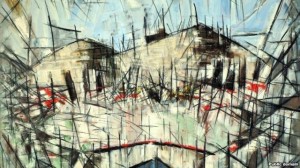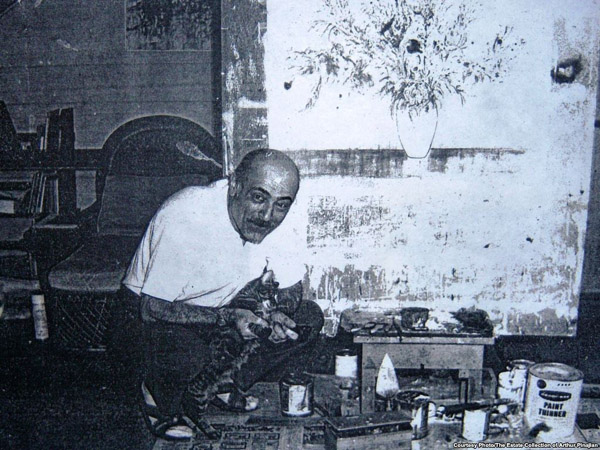By Richard Solash
WASHINGTON, DC (RFE/RL) – A landscape dissolves into reds, yellows, and greens. A mountain in New York State is filtered through an artist’s imagination, rendered on canvas in angular patches.
These were among the visions of Arthur Pinajian, an unknown Armenian-American painter whose death in 1999 prompted little more than the rental of a dumpster. The dumpster was to be filled with decades’-worth of his writings and pencil sketches and a garage-full of paintings that numbered close to 6,000.
Today, Pinajian’s work hangs on the well-lighted walls of a SoHo gallery. Leading art historians say that at his best, he ranks among America’s finest abstract expressionists. His estate has been appraised at $30 million. After several kind twists of fates, Pinajian has been vaulted out of obscurity and is now gaining improbable posthumous fame.
“I came into the house to look at it with the purpose of figuring out if it was a good house to flip (eds: buy and resell for profit) and I walked among all of this art. I was intrigued by it because it was so vast. I started looking closely at it and it was clear that the signature that was across the works was the same artist. Based on dates, it seemed like there were works spanning 5 decades at least. I knew what I was looking at was someone’s life’s work.”


Thomas Schultz was living in the sleepy town of Bellport, New York in 2005 when he and a friend decided to take advantage of an uptick in the real estate market. A modest two-bedroom cottage had been listed for sale that, with a bit of renovation, seemed like it could turn a profit. Its owner, a woman named Armen Pinajian, had recently passed away.
Schultz says the woman’s cousins apologized for the unusual mess left inside — thousands of canvases, some bitten by mold and mildew, that were stuffed into the attic’s rafters and piled up in the garage. A dumpster was ready for them out back.
??The artist, Arthur Pinajian, had died at 85 ahead of his sister, whom he had lived with for most of his life. Accounts by family members indicate she was the artist’s biggest fan, working as a clerk in a pipe company to support her brother’s creative aspirations. The few attempts by the artist to win recognition during his lifetime were unsuccessful.
The cousins said Pinajian had left instructions for all of his work to be thrown away. They would have already disposed of it, Schultz says, had one of them from out of town not arrived at the last minute and literally carried paintings back from the curb.
Schultz’s friend put up around $300,000 for the house and $2,500 for the entire body of work.
The enormous collection had not only been spared, but had fallen into the right hands. Schultz happened to know a relative of the late William Innes Homer, one of the most respected scholars of contemporary American art.
After several months of study, Homer would make an excited call to noted American art historian and appraiser Peter Hastings Falk:


“If you look at the history of abstraction in America, certainly the headlines are given to [Jackson] Pollock and Franz Kline and [Willem] de Kooning and all of the stars of that period who are now ensconced in the pantheon of American art history. And it’s long been thought that no one else could ever crack into that elite rank because, of course, everyone has been discovered and art historians already know everything. The really fun thing about this is here is the dean of American art historians who is just simply astonished — and I was, too. That’s what makes this such an extraordinary story.”
Falk is now the exhibitions director and chief curator of the Pinajian estate. (http://www.pinajianart.com/Default.htm)
While Pinajian tried everything from erotica to realism, Falk says he achieved his best in “lyric, rhythmic, abstract landscapes.”
Falk is also the editor of the first monograph on the artist, which sheds light on his psychology and formative years.
Pinajian was born in 1914 in a largely Armenian-American community in New Jersey. His parents had fled their home in Diyarbakir, present-day Turkey, before the height of World-War-I-era mass killings of ethnic Armenians by Ottoman Turks. His Armenian name was Ashod, while his friends knew him as “Archie.”
Pinajian’s artistic career began in the 1930s as a comic-book illustrator. He created “the first cross-dressing super hero” in a series titled “Madam Fatal.” (http://hyperallergic.com/63575/from-the-archives-the-first-cross-dressing-superhero/)
He earned a Bronze Star for valor for his service in World War II before training at the Art Students League in New York. Falk says that Pinajian likely came into contact with the well-known American abstract expressionists of the day.


The year 1948, however, was perhaps the most pivotal in Pinajian’s development. Falk says that Pinajian had “some sort of breakdown,” which resulted in his writing a lengthy manifesto on what it means to be a great artist. It was then, Falk says, that Pinajian “embarked on his quest with single-minded focus.”
By that time, Pinajian and his sister had moved to Woodstock, in upstate New York. Falk notes that 1948 was also the year that Arshile Gorky, the most famous Armenian-American artist, committed suicide. He had been in Woodstock as well, leading some to speculate that perhaps the two had met.
In Woodstock and then in Bellport, Pinajian led a near-hermetic existence, with art consuming nearly every waking hour until his death.
Aram Aramian, one of Pinajian’s cousins, told RFE/RL:
“When we went to the house he was always laughing and joking and talking about the old times and about the relatives and he took a general interest in my family. He was really pleasant; he had a good nature about him. But all he wanted to do was paint — paint, paint, paint. Morning, noon, and night. Every day. Three hundred and sixty five days out of the year.”
Aramian says Pinajian gave his family several paintings over the years to store, as the artist ran out of room.
In Woodstock, Pinajian found his muse in nearby Overlook Mountain. The image of the double-peaked mountain became a recurring theme, progressing from a recognizable portrayal to near complete abstraction.
Falk says he later realized that the mountain may have reminded Pinajian of Mount Ararat in present-day Turkey, the site where Noah’s Ark was said to have come to rest and an important symbol of Armenia.
Linda Stepanian, the president of Stephanie’s Art Gallery in California, is one of the leading dealers of Armenian art in the United States. In 2010, her gallery was the first to sell Pinajian’s works commercially.
Three years later, she says she has sold paintings to Armenian-Americans, Russians, and collectors in London and Paris.
“I am positively sure that he will be acknowledged in his ethnic homeland one day,” she says. “That will be the next step.”
She says her prices for Pinajian range from about $3,000 to $70,000 and are only going up.
Falk puts the total value of Pinajian’s work at $30 million, a figure that was recently revealed to the public.
He says significant interest was generated by Pinajian’s first New York City showing, which he arranged this month. That was the site of the highest price paid so far for a Pinajian work, $100,000.
“I still feel that the elevator is on the ground floor in terms of value,” Falk says.
Thomas Schultz, who first stumbled upon the Pinajian cottage, has given up his day job to become the full-time registrar of the collection. He says “a major Los Angeles-area museum” has recently acquired a piece. He also says a producer is pitching the story of Pinajian’s discovery to the popular U.S. television network HBO.
But Schultz stresses that his work is about inspiration far more than it’s about money:
“I bought the Pinajian cottage from my partner. I’m currently living in it. I look at the trees here on the property that he captured in some of the beautiful landscapes that we now see. So it’s almost like I’m on sacred ground. It’s been life-changing. [My life is] all things Pinajian, basically. I wake up every day and I think of Pinajian and what I could do to bring the recognition to him that he deserves. I feel like he’s finally getting that.”










